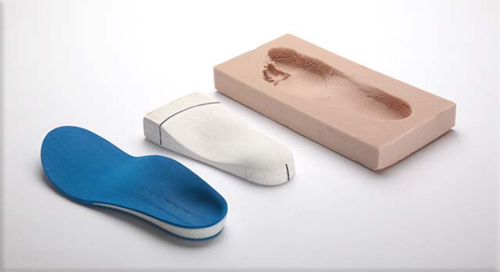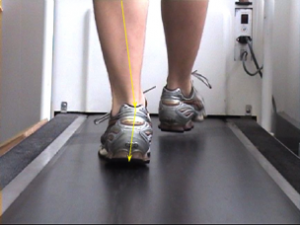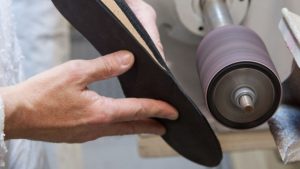
Orthotics can be fantastic devices. Like glasses that help us see and perform our best each day, orthotics work to alter the way our feet, muscles and bones move with the goal of optimising our overall function and reducing pain, excess pressure and unnecessary fatigue.
Unlike glasses, however, that do not come into direct contact with our eyes, the daily force placed on the orthotic can cause them to wear out over time. While this is not new information and is (or at least should be) detailed by your Podiatrist when discussing orthotics, it is something that can be easily forgotten or taken for granted when your foot pain is gone and you’re performing well – until your pain quickly returns and you’re not sure why.
To put things in perspective, here are 3 quick reasons why you should be seeing your Podiatrist for an orthotic check every year – or two at most.
1. Regardless of how long you’ve had them, your orthotics are working every day.
 Whether you realise it or not – your orthotics are constantly under a lot of pressure. To be precise, you’ll be exerting at least all your body weight over both orthotics – and when you’re running, this can increase to 3 – 4 times your body weight.
Gradually, this can lead to the wear down and compression of your orthotic materials, which affects their ability to provide the support, control and function that they were designed to – and initially would have.
Just like how you’d sharpen a blunt knife so it could keep working effectively, it’s important to check that your orthotics are still doing their job. If they’re not, it doesn’t mean that you’ll always need a completely new set of orthotics. Sometimes, it’s simply a matter of replacing the top cover, reinforcing the control of your orthotics or replacing your pad or addition. You won’t know until you have them checked – and it can be as quick and easy as a 15min check appointment!
Whether you realise it or not – your orthotics are constantly under a lot of pressure. To be precise, you’ll be exerting at least all your body weight over both orthotics – and when you’re running, this can increase to 3 – 4 times your body weight.
Gradually, this can lead to the wear down and compression of your orthotic materials, which affects their ability to provide the support, control and function that they were designed to – and initially would have.
Just like how you’d sharpen a blunt knife so it could keep working effectively, it’s important to check that your orthotics are still doing their job. If they’re not, it doesn’t mean that you’ll always need a completely new set of orthotics. Sometimes, it’s simply a matter of replacing the top cover, reinforcing the control of your orthotics or replacing your pad or addition. You won’t know until you have them checked – and it can be as quick and easy as a 15min check appointment!
2. If your orthotics helped alleviate your original symptoms – how would it affect your life if they came back?
Orthotics are not an ‘on-the-whim’ purchase. They’re a medical device and an investment into your health and mobility for the years to come. They have a very specific function that was prescribed and created by a foot health professional with years of experience in relieving symptoms and improving quality of life. This function may be to stop your foot rolling in and flattening so much, as it was irritating your posterior tibial tendon or plantar fascia and causing pain down the inside of your foot and ankle or the heel. It may be to provide additional stability to your foot and ankle as you’d suffered repeated ankle sprains and had developed some chronic ankle instability along the way. It may have been because your high-arched foot was lacking the shock absorbing function it needed to keep your feet from feeling sore and tired after a long shift on your feet.
Whatever the function – if your pain was alleviated (or at least significantly reduced in the case of arthritic pain) by your orthotics, then there’s a good chance that without the adequate support and control from your orthotics, that this pain can come back. And it’s not only the pain that comes back.
Pain happens for a reason. It’s a sign that something is wrong – that an injury has occurred – and the pain is a by-product of the damage. When your pain comes back, it means an injury has again occurred and that’ll take time to heal and for the pain to go, even after you repair or replace your orthotics. And that can take a significant toll on your quality of life!
3. Your foot structure and position, along with your bone and muscle strength and function, change over time. Your orthotics may need to too.
 As with everything in our lives, we are always changing – and so are our bodies. Our muscles may grow stronger or weaker. Certain medications or events may affect our tissues and the way they function. Our feet change, but they do so very gradually, at a rate that we may not be able to notice. So while we may presume that our feet are the same today as they were 3 years ago, there’s only one way to find out – and that’s to have them checked!
When you come in for an orthotic check, we assess the function of your orthotics against both the reason you needed your orthotics in the first place, and against your feet in their current state. The ultimate question that we look to answer is:
As with everything in our lives, we are always changing – and so are our bodies. Our muscles may grow stronger or weaker. Certain medications or events may affect our tissues and the way they function. Our feet change, but they do so very gradually, at a rate that we may not be able to notice. So while we may presume that our feet are the same today as they were 3 years ago, there’s only one way to find out – and that’s to have them checked!
When you come in for an orthotic check, we assess the function of your orthotics against both the reason you needed your orthotics in the first place, and against your feet in their current state. The ultimate question that we look to answer is:
“are your orthotics in their current state effectively supporting and controlling your feet in their current state?”
If the answer to this question is yes, then that’s fantastic! It’s exactly what we want. If the answer to this question is no, then we’ll figure out why (is it your feet, is it the orthotics, are there other influencing factors like your footwear) and discuss with you the best ways to correct this so you can stay happy, healthy and active for the foreseeable future.
Need that orthotic check after all?
Easy – just book in using our free online booking form here, or give our team a call on 09 523 2333 and book in your appointment. We hope that you’ve been feeling great and performing well – and hope to see you soon!
 Whether you realise it or not – your orthotics are constantly under a lot of pressure. To be precise, you’ll be exerting at least all your body weight over both orthotics – and when you’re running, this can increase to 3 – 4 times your body weight.
Gradually, this can lead to the wear down and compression of your orthotic materials, which affects their ability to provide the support, control and function that they were designed to – and initially would have.
Just like how you’d sharpen a blunt knife so it could keep working effectively, it’s important to check that your orthotics are still doing their job. If they’re not, it doesn’t mean that you’ll always need a completely new set of orthotics. Sometimes, it’s simply a matter of replacing the top cover, reinforcing the control of your orthotics or replacing your pad or addition. You won’t know until you have them checked – and it can be as quick and easy as a 15min check appointment!
Whether you realise it or not – your orthotics are constantly under a lot of pressure. To be precise, you’ll be exerting at least all your body weight over both orthotics – and when you’re running, this can increase to 3 – 4 times your body weight.
Gradually, this can lead to the wear down and compression of your orthotic materials, which affects their ability to provide the support, control and function that they were designed to – and initially would have.
Just like how you’d sharpen a blunt knife so it could keep working effectively, it’s important to check that your orthotics are still doing their job. If they’re not, it doesn’t mean that you’ll always need a completely new set of orthotics. Sometimes, it’s simply a matter of replacing the top cover, reinforcing the control of your orthotics or replacing your pad or addition. You won’t know until you have them checked – and it can be as quick and easy as a 15min check appointment!
 As with everything in our lives, we are always changing – and so are our bodies. Our muscles may grow stronger or weaker. Certain medications or events may affect our tissues and the way they function. Our feet change, but they do so very gradually, at a rate that we may not be able to notice. So while we may presume that our feet are the same today as they were 3 years ago, there’s only one way to find out – and that’s to have them checked!
When you come in for an orthotic check, we assess the function of your orthotics against both the reason you needed your orthotics in the first place, and against your feet in their current state. The ultimate question that we look to answer is:
As with everything in our lives, we are always changing – and so are our bodies. Our muscles may grow stronger or weaker. Certain medications or events may affect our tissues and the way they function. Our feet change, but they do so very gradually, at a rate that we may not be able to notice. So while we may presume that our feet are the same today as they were 3 years ago, there’s only one way to find out – and that’s to have them checked!
When you come in for an orthotic check, we assess the function of your orthotics against both the reason you needed your orthotics in the first place, and against your feet in their current state. The ultimate question that we look to answer is:
